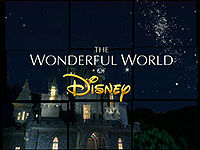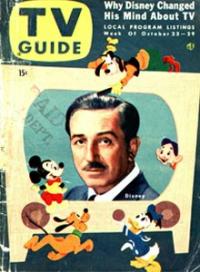From its debut on ABC in October 1954, through its final telecast on Christmas Eve 2008, the Walt Disney anthology television series commonly known as The Wonderful World of Disney (initiallycalled simply Disneyland) appeared on all three broadcast TV channels at various times under a variety of names, becoming the second-longest-running prime-time program on American television. Watching the show with my family when I was growing up, I was of course oblivious to Disney’s incredibly forward-thinking synergy strategy, with the TV show, the Disney studio’s theatrical films, and the new Disneyland theme park all designed to promote and market each other and strengthen the overall Disney brand. All I knew was that the show was fun to watch and something that my mom and dad enjoyed watching with me.
The format was a mixture of cartoons, live-action adventures, documentaries, and nature stories, all initially hosted by the affable Walt Disney himself. Much of the material came from the Disney studio library, including one-hour edits or multi-part miniseries of recent Disney films. Unlike the heads of the other major Hollywood movie studios at the time, Disney didn’t worry that the new television medium would destroy his movie business. On the contrary, he understood that he could use his TV show to promote and extend the life of his theatrical releases, and vice versa.
A good example of this synergy was the huge success of the 3-part miniseries about the historical American frontiersman Davy Crockett that aired under the show’s umbrella in 1955. In the ensuing Davy Crockett craze, the show’s theme song, “The Ballad of Davy Crockett,” became a hit record, and Disney sold millions of dollars of Davy Crockett merchandise. Every child I knew had a Davy Crockett lunch box, coonskin hat, fringed jacket or pants, or similar paraphernalia. Then Disney edited the TV episodes into two theatrical films that were quickly released to benefit from and build upon the show’s popularity.
Walt Disney approached both NBC and CBS with his plans for producing a TV series, but he ultimately chose third-place network ABC for the debut of Disneyland, because ABC was willing to give him what he wanted in exchange — a $500,000 investment in the amusement park he dreamed of opening in Anaheim, California. ABC executives were desperate to obtain programming that would give them an edge against their two more established rivals, and they were also very interested in attracting the growing family market in those baby-boom years. ABC’s investment paid off quickly, as Disneyland became the network’s first series to hit the top ten in ratings.
When the Disneyland theme park opened in July of 1955, ABC aired a live special honoring the new tourist mecca and its founder. Within a year, millions of Disneyland viewers who had seen the park constantly promoted on the TV show poured into Disneyland. In its first year, the theme park grossed $10 million. Walt Disney and his company had shaped two new entertainment forms and interlinked them in a strategy that continued to generate millions of dollars in profits over the ensuing decades.
In this clip from the series’ premiere episode, you can see how the show helped to promote both the Disney studio’s movie line-up and the planned theme park:
 In 1961, Disney moved the show to NBC to take advantage of the fact that it was the first network to broadcast in color. In another prescient decision, Disney had filmed many of his earlier shows in color, even though they could only air in black and white at the time. With the move to NBC, he could now repeat these shows in full color. The series was renamed Walt Disney’s Wonderful World of Color and aired under that name until 1969.
In 1961, Disney moved the show to NBC to take advantage of the fact that it was the first network to broadcast in color. In another prescient decision, Disney had filmed many of his earlier shows in color, even though they could only air in black and white at the time. With the move to NBC, he could now repeat these shows in full color. The series was renamed Walt Disney’s Wonderful World of Color and aired under that name until 1969.
Walt Disney, an inveterate cigarette smoker, died of lung cancer on December 15, 1966. The intros he had filmed before he died remained a part of the show for the rest of that season, but the host segment was then dropped. The series was retitled The Wonderful World of Disney in 1969 and remained popular through the mid-70’s. At that point, however, the show’s audiences began to decline, as popular tastes changed and the public began to see the Disney brand as square, uptight, and unhip, qualities that America’s youth were turning away from.
In 1979, in an attempt to revive the series’ fortunes, it was retitled Disney’s Wonderful World and given a new opening sequence with a computer-generated logo and disco-flavored theme song.
But growing competition from CBS’s new 60 Minutes newsmagazine show combined with frequent preemptions and cancellations by NBC, led to further ratings declines, and NBC cancelled the show in 1981.
CBS then picked up the program and retitled it simply Walt Disney. It ran for another two years, until the debut of the Disney Channel on cable TV. The Disney company then decided that the broadcast show and the fledgling cable channel would cannibalize each other, and production of the program was ended. However, after a change in management at the Disney company, the series was revived in 1986 under the title The Disney Sunday Movie, with new Disney CEO Michael Eisner as host. This version of the show had a movie-of-the-week format, featuring family-oriented TV movies produced by the Disney studio, as well as occasional theatrical films.
The series moved back to NBC in 1988 as The Magical World of Disney, with its original anthology format. But it did not do well and was cancelled in 1990. The Disney Channel continued to use The Magical World of Disney as the umbrella title for its Sunday night movies and specials until 1996. In 1997, after Disney purchased ABC, the series was revived again as The Wonderful World of Disney, airing on Saturday or Sunday evenings until its finale on December 24, 2008, with a telecast of the feature film The Chronicles of Narnia: The Lion, the Witch, and the Wardrobe.
Walt Disney’s endearing on-screen personality made him an icon of American popular culture. His television series provided wholesome, high-quality, family-oriented entertainment for generations of viewers. And his marketing acumen created a multi-media juggernaut that combined television, movies, theme parks, and licensed merchandise into one of the most successful and powerful brands in the world.
Among the many books and DVD’s about the Disney TV series, I suggest the following:
Walt Disney Treasures – Disneyland USA (1955): A 2-disc DVD set of TV specials for the opening of the Disneyland amusement park, hosted by movie/TV historian Leonard Maltin
Walt Disney Treasures – Your Host, Walt Disney: A DVD compilation of several of the most memorable hours from the Disney TV show
Walt Disney: The Triumph of the American Imagination (Paperback): An insightful biography of Walt Disney, by Neal Gabler
The Magic Kingdom: Walt Disney and the American Way of Life (Paperback): Part biography and part cultural analysis, an anatomy of Disney’s productions and their consumption, by Steven Watts.
The Collectionary is a great place to visit if you collect Disney objects. Link to the Collectionary here.


Recent Comments